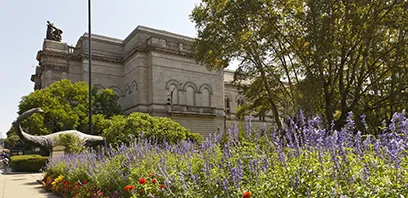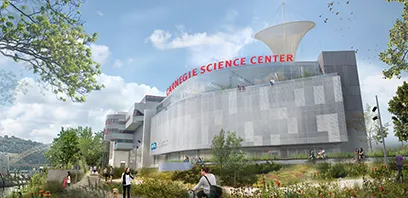There is a belief among the Apsáalooke people that their objects should be seen and remembered. Such objects have their own agency and are part of a spiritual ecology where all things are connected to one another. Yet, these objects are often tucked away in museum drawers in archival collections, only seen by a handful of staff tasked with caring for them.
“When you have something so spectacular and beautiful and wonderful, you are going to want to hold onto it. You are going to want to preserve it,” says Nina Sanders, a scholar, curator, and member of the Apsáalooke (pronounced ap-SAH-loo-gah) Nation, also known as the Crow. “That is the conundrum of museums.”
‘Decolonizing the Institution’: Read about how Carnegie Museum of Natural History is working to decolonize its collection.
Sanders, whose Apsáalooke name Akbileoosh means “Brings the Water,” sought to change the way her tribe’s artifacts are cared for and presented at the Field Museum in Chicago, where more than 100 Apsáalooke war shields are held in the permanent collection, along with war shirts, headdresses, cradle boards, elk tooth dresses, and beadwork dating back to the 1850s.
The resulting exhibition, Apsáalooke Women and Warriors, which was curated by Sanders in collaboration with her community, is now on display at Carnegie Museum of Natural History through May 29. It is the largest exhibition in the tribe’s history and the first to pair artifacts and sacred objects with contemporary art, fashion, music, storytelling, and beadwork made by the Apsáalooke people. When it opened, it was the first major exhibition curated by a Native American scholar in Field Museum history.
Apsáalooke Women and Warriors represents a pivotal moment for museums in how to exhibit and care for objects through consultation and partnership with Indigenous nations. This includes different methods of handling, storing, and displaying culturally sensitive materials in appropriate ways, depending on tribal customs, describes Sarah Crawford, director of exhibitions and design for Carnegie Museum of Natural History.
“It takes time and patience and understanding in these conversations,” says Crawford. “It’s not about us, and we should not view our agenda as a priority. We need to go into these conversations and be open to changing our practices.”
 © Field Museum photo by John Weinstein
© Field Museum photo by John WeinsteinPowerful Collaboration
The exhibition showcases aspects of Apsáalooke culture prior to colonization and the role of women within the society. The origin story of the Apsáalooke people begins with Iichiikbaaliia, the “First Maker,” who spread clay from the earth and created the first man and woman equally. Throughout the exhibition, gender roles are explored within the warrior culture and the roles women played throughout history.
During the curation of Apsáalooke Women and Warriors, members of the tribe traveled to the Field Museum to interact with objects made by their ancestors—from ordinary utilitarian items to unfinished beadwork and parade regalia for warriors and horses.
 © Field Museum photos by John Weinstein
© Field Museum photos by John WeinsteinMany of these objects were taken from their communities for museum collections at the turn of the 20th century. It was a time when Native American people were being forcibly removed from their homelands, diseases were decimating tribal nations, children were separated from their families, food was scarce, and cultural objects and possessions were being heavily collected, often under predatory conditions, with the assumption that Native Americans would not survive colonization.
Today, there are approximately 12,000 enrolled members of the Apsáalooke Nation. Their historical homelands extended across parts of present-day Montana, Wyoming, and South Dakota.
In 2022, when the exhibition traveled to the Museum of the Rockies in Bozeman, Montana, it represented the first time these objects had been on traditional homelands of the Apsáalooke in more than a century.
 © Field Museum photos by John Weinstein
© Field Museum photos by John WeinsteinSanders describes such objects as a way to live with her ancestors: “They are precious things. The objects of this earth compel us to want to create and be created. They are a source of power.”
Tribal elders held a private ceremony in Montana that September to bring the shields into the sunlight to bless and honor them. As the rawhide warmed, it gave off a distinct odor, as it may have done when originally being hardened over fire. Each shield was made from the thickest part of a buffalo hide, put over fire to pull out moisture and thicken the rawhide, then adorned with objects or representations of a warrior’s medicine, including animal parts, feathers, pigments, and drawings.
This was the first time the shields had seen the sun, heard the language of the Apsáalooke, or felt the touch of their descendants since leaving their original makers.
“It was a moment where I understood the concept of ‘time doesn’t exist,’ because it was obvious to me that everything that unfolded to that point could not be fully a human construct,” Sanders says. “The fact that it happened is what is pivotal.”
“When you have something so spectacular and beautiful and wonderful, you are going to want to hold onto it. You are going to want to preserve it. That is the conundrum of museums.”
– Nina Sanders, a scholar, curator, and member of the Apsáalooke nation
Bringing artifacts outdoors or into the sunlight is unheard of by museum standards, which are designed to preserve objects in a temperature-controlled and secured facility. The ceremony was the culmination of efforts by the Apsáalooke people, who have long been excluded from conversations regarding the cultural material of their ancestors, to work in closer partnership with museums.
“It creates this stern conversation in the community, in museums, and in Indian country,” Sanders explains. “Why are these people showing these incredibly powerful, sacred items? People are going to ask this question, no matter where they come from.”
Aaron Brien, director of the Crow Tribal Historic Preservation Office and a tribal historian, assisted Sanders during the process of curating Apsáalooke Women and Warriors and was able to hold war shields made by his direct ancestors.
“It’s like meeting relatives; you quickly forget about the institution, and you are enthralled by the items,” describes Brien, whose Apsáalooke name is Bachíiakuashdesh, which means “Goes to the Middle of War.” While reviewing cataloged materials, Brien discovered the shield for which his ancestor, Ishbínnaache Ítchisn (Pretty Shield), was named.
“It placed an individual that was born in 1856 right in front of me,” he says. “And that was one shield. We did that with 30 of them.”
 © Field Museum photo by John Weinstein
© Field Museum photo by John WeinsteinShield Stories
There was a time when most Apsáalooke men had a war shield, used either physically in war or as a spiritual component of war, and they were cared for in partnership by families. Women would place them in the sun as part of a ceremony.
“The social organization of the Crows works from the interior of the lodge out,” Brien explains. “Everyone is doing things in reciprocity.”
The shields are considered “baaxpaá,” which means holy or sacred. “We have only one word for holy and these things,” explained the late Grant Bulltail, an Apsáalooke elder, oral storyteller, and culture-bearer, who is quoted in the catalog created for the exhibition. Baaxpaá is “to be with God” or a “powerful source of energy,” all of which is interconnected to the natural world.
Because of their importance, shields became objects to be desired by outsiders. A collector named Stephen Simms working on behalf of the Field Museum obtained more than 100 war shields from various Apsáalooke families in 1901 and 1902, according to Sanders’ research.
“We don’t have a complete record of the shields, but what we do have is the conversation started,” says Brien. “That these shields went on exhibit triggered something among Crow people where they are talking about them. Whether that’s positive or negative, it’s all going into this bank of information.”
“We have communicated with staff that this is a completely different exhibition, and it is an honor that we are being allowed and permitted to exhibit these sacred objects.”
– Sarah Crawford, director of exhibitions and design for Carnegie Museum of Natural History
Only a select few of the shields are part of Apsáalooke Women and Warriors, and each shield on display is ceremoniously guarded by an enlarged historic portrait of an Apsáalooke woman.
Amy Covell-Murthy, archaeology collection manager for Carnegie Museum of Natural History, is part of the team that unpacked the exhibition and completed condition reports on the materials. Because each Indigenous community has widely different and vibrant cultural practices, how the objects are handled varies by tribe. “That is why consultation is so important,” Covell-Murthy says.
Groundwork was laid for how Carnegie staff should operate with these cultural items, and the exhibition installation was overseen by Field Museum staff and Apsáalooke tribal members.
“We have communicated with staff that this is a completely different exhibition, and it is an honor that we are being allowed and permitted to exhibit these sacred objects,” says Crawford. “The whole staff needs to understand what this means.”
There were additional cultural protocols involved in unpacking and installing the exhibition, she explains. That included a “smudging” ceremony in which tribal members burned dried and bound sage and shared prayers when the crates were opened.
Covell-Murthy expects that these special measures will become more standard as museums shift their practices when working with cultural items.
“There are different ways of knowing, and it’s important to honor tribal ways of seeing and relating with their cultural materials,” she says.
For Sanders, working within museum spaces has come with a heavy toll, and she describes herself as a different person than when she began curating Apsáalooke Women and Warriors.
“I feel like I relived some of the things that happened when these objects were being taken out of our community,” she explains. “I would have moments where I would just be overcome with this profound sense of loss.”
Yet, it was Sanders who paved the way for museum staff to conceive of cultural exhibitions differently.
“We used to build them to last forever,” says Crawford. “Now, we are shifting more toward inviting community voices to be central to exhibitions.”
Apsáalooke Women and Warriors is jointly organized by the Field Museum and the Neubauer Collegium for Culture and Society at the University of Chicago.







